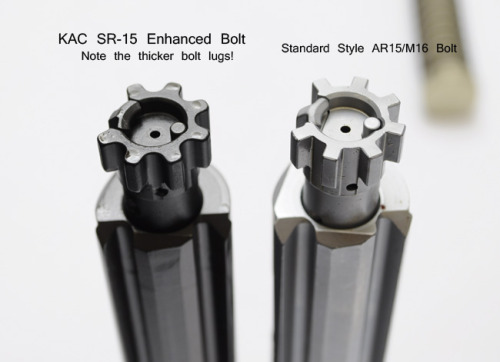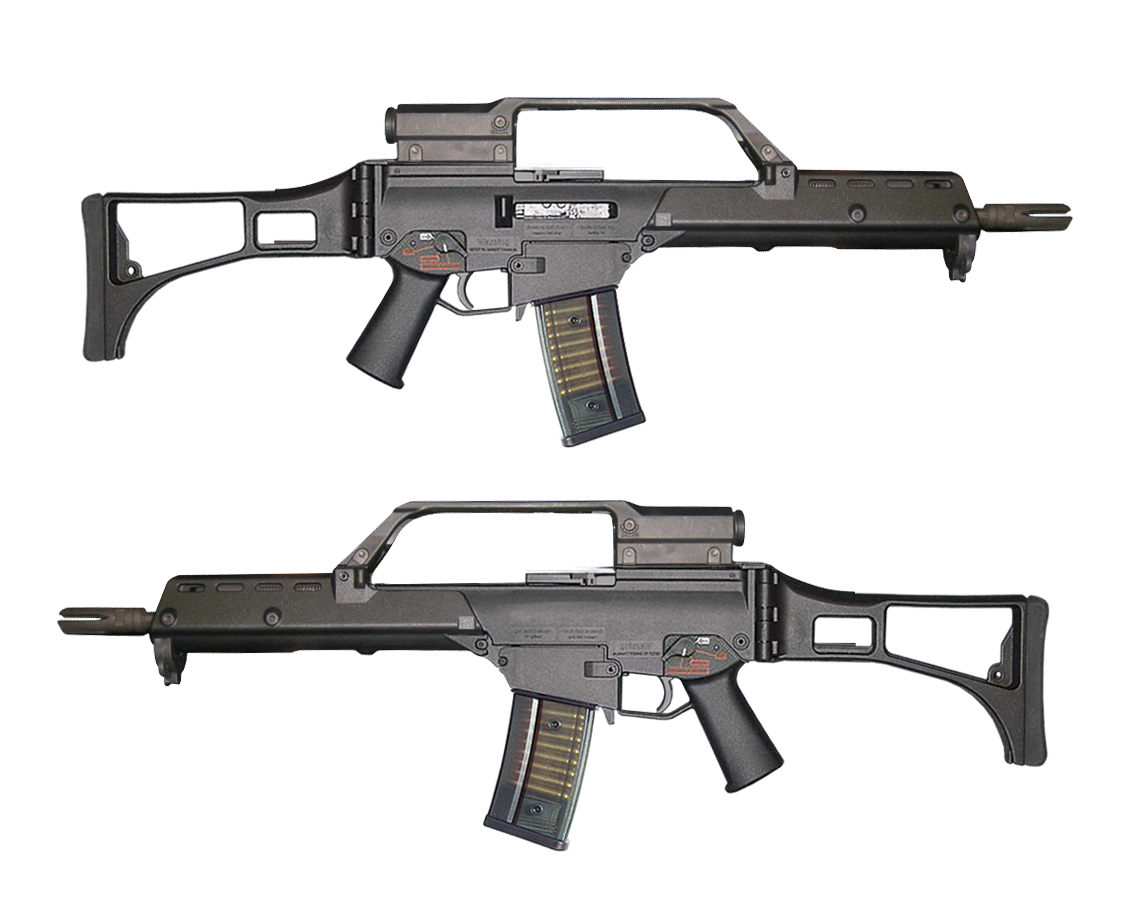As a professional defense industry consultant, I am involved in a project looking at future military ammunition types. I am not a ballistics expert, but as an ex-infantry platoon leader and company commander, I know something about how such products are used by the end customer!
Over the last 12 months several NATO armies have begun to look at the issue of caliber. The speed and ease with which the 8.59 mm cartridge has become a new and de facto NATO sniping calibre and, similarly, the way in which the 4.6 mm round has become a a de facto PDW standard has reassured military procurement personnel that maybe the barriers to caliber change are not so great.
For this reason, both the 6.8 mm Remington SPC and 6.5 mm Grendel have been evaluated quite extensively. To cut a long story short, the 6.8 mm Remington provides demonstrably superior terminal effectiveness to that of the M855 5.56 mm NATO round at all ranges to 400 metres. The problem is, however, that we need to engage targets at ranges of up to 600 metres in assault rifles (usually as a squad firing collectively), up to 800 metres for DMRs, and up to 1,200 metres for machine gunners with LMGs / SAWs. There is also the problem of Level III and Level IV body armour. Without extended range and power, the 6.8 mm SPC cartridge is not a valid substitute for 5.56 mm NATO.
Consequently, we have seen the wider re-introduction of 7.62 mm at squad level. Now that every UK infantry soldier is required to carry 200 rounds of belted 7.62 mm in addition to his own kit, we've all been reminded of the weight disadvantages of this larger calibre, not to mention the problem of training soldiers to shoot accurately with a rifle that has greater recoil.
Are we really stuck with 5.56 mm and 7.62 mm? It's starting to become obvious that the 5.56 mm M855A1 EPR is still most effective below 500 metres despite claims to the contrary. There are other concerns that I am sure everyone here is aware of, including massive costs. Meanwhile, 7.62 mm remains very inefficient, so loses energy rapidly. The thing is it works.
Against this backdrop the armies of several NATO members are looking at alternate calibers. Not surprisingly the 6.5 mm Grendel is starting to receive a lot of attention. (Kudos to you Bill A) it is certainly a highly respected solution and is now being evaluated widely. With all due respect to forum members own testing, a consensus opinion about the Grendel appears to be forming from within the military community. Let me underline the issues:
I have mentioned elsewhere that tests conducted by an EU manufacturer using piston AR15s showed marked energy reductions with weapons having barrels of 12" and 14.5" and 16" versus 24" and 20" barrels. Alas, I cannot cite my data sources. Apologies.
If we assume then that the Grendel, good as it is, is fine for target shooting and hunting, what could be done to make it a better military calibre? if anything.
The question I asked before remains valid: does it need a larger case to (a) give it more energy to compensate for shorter barrels (b) to ensure it is blind to yaw and blind to barrier (c) so that it matches 7.62 mm across all situations with a cartridge that is the same across all dimensions except for weight and recoil and (d) to compensate for generally lower standards of ammunition quality for military purposes?
Secondly, does the bullet need to be redesigned? Can anyone provide data on its lethality at short range?
This is open-ended research designed simply to gain perspectives from an expert user community. No one is suggesting that anyone's data is bogus, but military standards do differ from civilian ones. Similarly test methods also vary.
Feel free to PM me if you wish.
Thanks in anticipation.
Over the last 12 months several NATO armies have begun to look at the issue of caliber. The speed and ease with which the 8.59 mm cartridge has become a new and de facto NATO sniping calibre and, similarly, the way in which the 4.6 mm round has become a a de facto PDW standard has reassured military procurement personnel that maybe the barriers to caliber change are not so great.
For this reason, both the 6.8 mm Remington SPC and 6.5 mm Grendel have been evaluated quite extensively. To cut a long story short, the 6.8 mm Remington provides demonstrably superior terminal effectiveness to that of the M855 5.56 mm NATO round at all ranges to 400 metres. The problem is, however, that we need to engage targets at ranges of up to 600 metres in assault rifles (usually as a squad firing collectively), up to 800 metres for DMRs, and up to 1,200 metres for machine gunners with LMGs / SAWs. There is also the problem of Level III and Level IV body armour. Without extended range and power, the 6.8 mm SPC cartridge is not a valid substitute for 5.56 mm NATO.
Consequently, we have seen the wider re-introduction of 7.62 mm at squad level. Now that every UK infantry soldier is required to carry 200 rounds of belted 7.62 mm in addition to his own kit, we've all been reminded of the weight disadvantages of this larger calibre, not to mention the problem of training soldiers to shoot accurately with a rifle that has greater recoil.
Are we really stuck with 5.56 mm and 7.62 mm? It's starting to become obvious that the 5.56 mm M855A1 EPR is still most effective below 500 metres despite claims to the contrary. There are other concerns that I am sure everyone here is aware of, including massive costs. Meanwhile, 7.62 mm remains very inefficient, so loses energy rapidly. The thing is it works.
Against this backdrop the armies of several NATO members are looking at alternate calibers. Not surprisingly the 6.5 mm Grendel is starting to receive a lot of attention. (Kudos to you Bill A) it is certainly a highly respected solution and is now being evaluated widely. With all due respect to forum members own testing, a consensus opinion about the Grendel appears to be forming from within the military community. Let me underline the issues:
- The Grendel doesn't quite match 7.62 mm at 1,000 metres across all combat scenarios
OTM bullets for precision target shooting are likely to provide better results than a lower standard military spec ammunition
Concern about loss of energy when ammo fired from shorter barrels
Concerns about high pressure loadings heating up weapons quickly in combat and possibly causing malfunctions
Need to ensure the bullet design combines maximum efficiency with terminal effectiveness at all ranges
I have mentioned elsewhere that tests conducted by an EU manufacturer using piston AR15s showed marked energy reductions with weapons having barrels of 12" and 14.5" and 16" versus 24" and 20" barrels. Alas, I cannot cite my data sources. Apologies.
If we assume then that the Grendel, good as it is, is fine for target shooting and hunting, what could be done to make it a better military calibre? if anything.
The question I asked before remains valid: does it need a larger case to (a) give it more energy to compensate for shorter barrels (b) to ensure it is blind to yaw and blind to barrier (c) so that it matches 7.62 mm across all situations with a cartridge that is the same across all dimensions except for weight and recoil and (d) to compensate for generally lower standards of ammunition quality for military purposes?
Secondly, does the bullet need to be redesigned? Can anyone provide data on its lethality at short range?
This is open-ended research designed simply to gain perspectives from an expert user community. No one is suggesting that anyone's data is bogus, but military standards do differ from civilian ones. Similarly test methods also vary.
Feel free to PM me if you wish.
Thanks in anticipation.


 There are no free lunches to be had, but the Grendel (In my opinion) hits the sweet spot exceedingly well. Factoring in size, weight, and recoil points squarely at the Grendel in my book.
There are no free lunches to be had, but the Grendel (In my opinion) hits the sweet spot exceedingly well. Factoring in size, weight, and recoil points squarely at the Grendel in my book. 







Comment